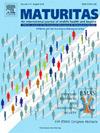绝经后妇女增加和持续的体力活动:阻力训练干预的2年随访
IF 3.6
2区 医学
Q2 GERIATRICS & GERONTOLOGY
引用次数: 0
摘要
目的:通过一项随机对照试验,评估绝经后最初低体力活动水平妇女的体力活动水平是否可以改变并持续2年。研究设计:有血管舒缩症状和低活动水平的绝经后妇女被随机分配到一个15周的监督下全身阻力训练计划中,每周3次或对照组保持低活动。干预后,对照组接受了入门性阻力训练和15周的健身房会员资格。在两年的随访中,两组人每六个月都会收到信息丰富和鼓励的电子邮件。主要结果:身体活动水平的改变。通过国际体育活动问卷(IPAQ)在基线、15周、6个月和2年对体育活动进行评估。数据分析采用Wilcoxon's signed rank、Friedman和Mann-Whitney U检验。结果65名随机分组的女性中,58名(89%)完成了为期2年的随访研究。在基线时,根据IPAQ评分,干预组21人,对照组15人不活动。两年后,每组减少到4例(分别为14%和16%)。从基线到两年内,两组均显著增加了中度至剧烈运动(干预组:中位数0至180分钟,p < 0.001;对照组:中位数0至125分钟,p = 0.004)。结论两组患者的体力活动水平均显著提高(干预组在15周的干预期间,对照组在15周至6个月的随访期间),并持续2年。抗阻训练课程、健身房会员、训练日记和支持性电子邮件构成了一种可行的策略,可以改善活动水平低的绝经后妇女的身体活动。本文章由计算机程序翻译,如有差异,请以英文原文为准。
Increased and sustained physical activity in postmenopausal women: 2-year follow-up of a resistance training intervention
Objectives
To assess whether levels of physical activity can be modified and sustained for 2 years in postmenopausal women with initially low physical activity levels participating in a randomised controlled trial.
Study design
Postmenopausal women with vasomotor symptoms and low activity levels were randomised to a 15-week supervised full-body resistance training program three times/week or a control group maintaining low activity. After the intervention, controls were offered an introductory resistance training session and 15-week gym membership. Both groups received informative and encouraging emails every six months during 2-year follow-up.
Main outcome
Change in level of physical activity.
Measures
Physical activity was assessed via the International Physical Activity Questionnaire short form (IPAQ) at baseline, 15 weeks, six months, and two years. Data were analysed with Wilcoxon's signed rank, Friedman, and Mann-Whitney U tests.
Results
Of 65 women randomised, 58 (89 %) completed the 2-year follow-up study. At baseline, 21 in the intervention and 15 in the control group were inactive according to IPAQ scores. After two years, this was reduced to four in each group (14 % and 16 %, respectively). Both groups significantly increased moderate to vigorous activity from baseline to two years (intervention group: median 0 to 180 min, p < 0.001; control group: median 0 to 125 min, p = 0.004).
Conclusions
Both groups significantly increased their level of physical activity (intervention group during the 15-week intervention, control group between 15-week and 6-month follow-ups) and maintained this for two years. A resistance training session, gym membership, training diary, and supportive emails form a feasible strategy to improve physical activity among postmenopausal women with low activity levels.
求助全文
通过发布文献求助,成功后即可免费获取论文全文。
去求助
来源期刊

Maturitas
医学-妇产科学
CiteScore
9.10
自引率
2.00%
发文量
142
审稿时长
40 days
期刊介绍:
Maturitas is an international multidisciplinary peer reviewed scientific journal of midlife health and beyond publishing original research, reviews, consensus statements and guidelines, and mini-reviews. The journal provides a forum for all aspects of postreproductive health in both genders ranging from basic science to health and social care.
Topic areas include:• Aging• Alternative and Complementary medicines• Arthritis and Bone Health• Cancer• Cardiovascular Health• Cognitive and Physical Functioning• Epidemiology, health and social care• Gynecology/ Reproductive Endocrinology• Nutrition/ Obesity Diabetes/ Metabolic Syndrome• Menopause, Ovarian Aging• Mental Health• Pharmacology• Sexuality• Quality of Life
 求助内容:
求助内容: 应助结果提醒方式:
应助结果提醒方式:


